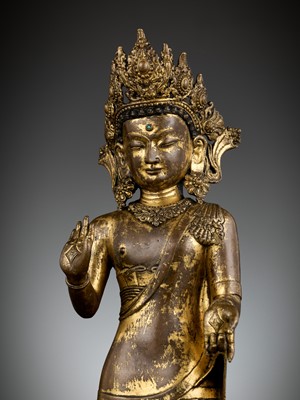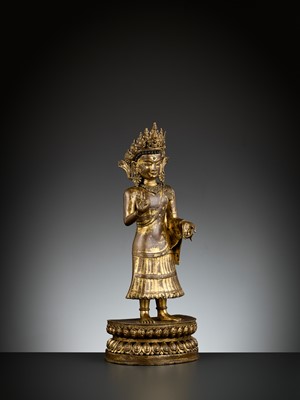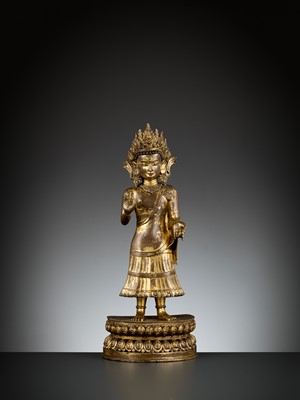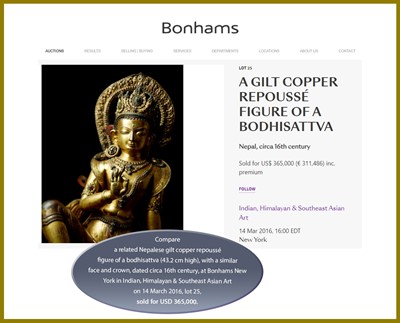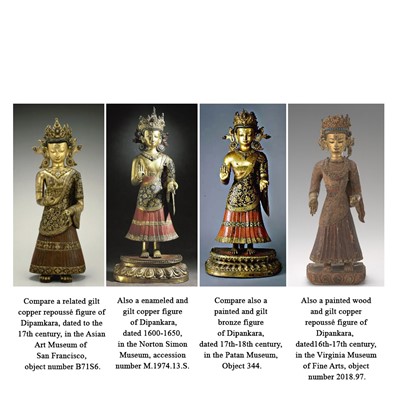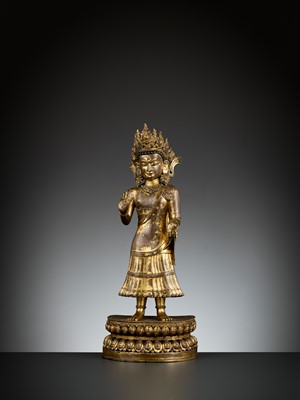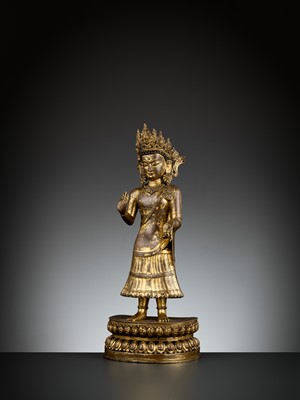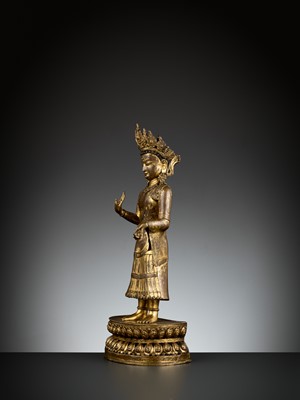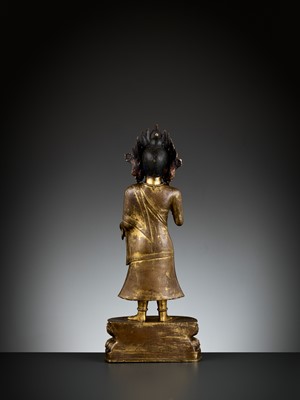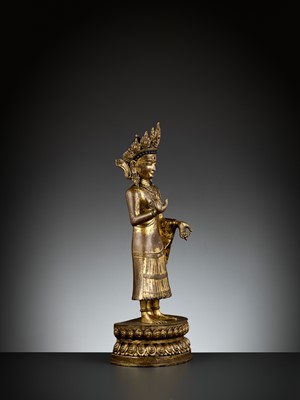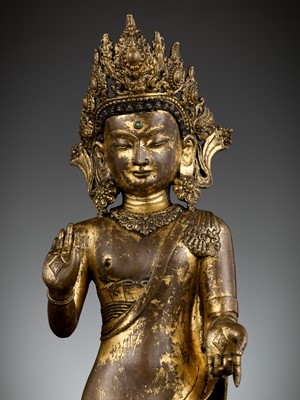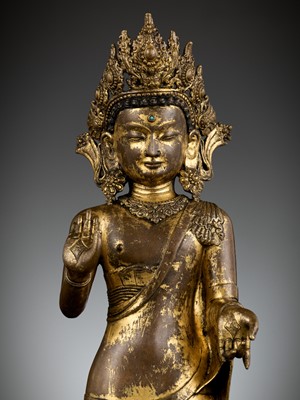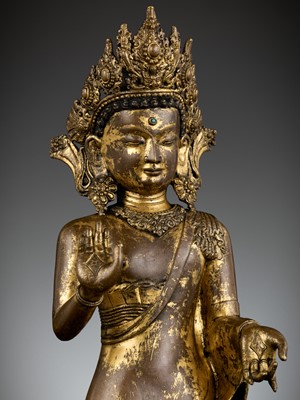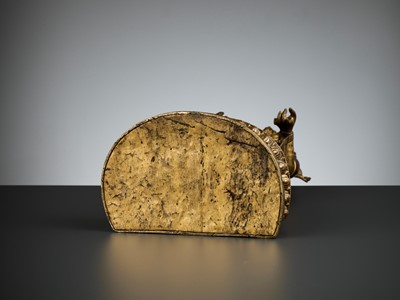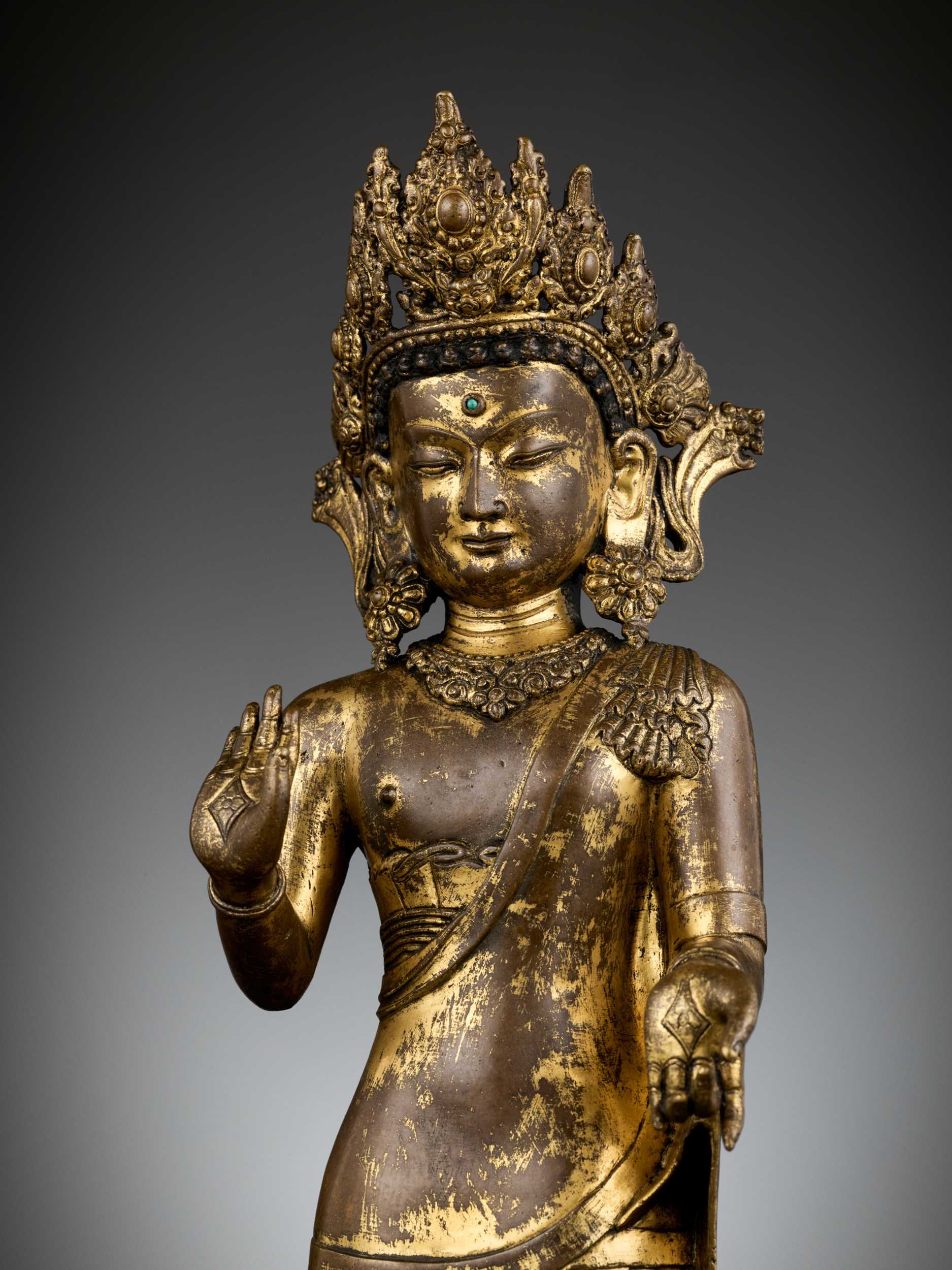16th Oct, 2021 10:00
TWO-DAY AUCTION - Fine Chinese Art / 中國藝術集珍 / Buddhism & Hinduism
379
AN EXCEEDINGLY RARE GILT BRONZE FIGURE OF DIPANKARA BUDDHA, LATE MALLA, THREE KINGDOMS PERIOD
尼泊爾馬拉王朝後期三國鼎立時期罕見銅鎏金燃燈佛
Sold for €22,000
including Buyer's Premium
Nepal, 1520-1768. Finely cast standing atop a pierced double-lotus base. His right hand is raised in the gesture of reassurance (abhaya mudra) and his left is in the gesture of teaching (vitarka mudra). He is wearing a long, flared robe, and richly adorned in beaded and floral jewelry.
Provenance: From an old private collection in the United Kingdom. A collector in London, England, acquired from the above, about twenty years ago.
Condition: Excellent condition with old wear, particularly to gilt. Minuscule nicks, few small dents, occasional light scratches. Remnants of pigment. Fine, naturally grown patina overall.
Weight: 5,070 g
Dimensions: Height 47.6 cm
The serene face with heavy-lidded almond-shaped eyes below elegantly arched eyebrows centered by a turquoise-inlaid urna, a broad aquiline nose, and full lips forming a subtle smile. The hair arranged in tight curls below the elaborate five-leaf crown and surmounted by an ushnisha behind.
Dipankara, one of numerous Buddhas of the past, is said to have predicted the coming of the historical Buddha Shakyamuni. According to legend, a rich Brahmin named Sumati saw that Dipankara was about to walk into a puddle of water. To prevent him from soiling his feet, Sumati laid his long hair across the puddle. Following this event, Dipankara prophesized Sumati’s rebirth as the future Buddha. Images of Dipankara in Nepal are worshipped as icons bestowing charity and protecting merchants.
The Three Kingdoms period – the time of the later Mallas – began in 1520 and lasted until the mid-eighteenth century. The complete flowering of the unique culture of the Kathmandu Valley occurred during this period, and it was also during this time that the old palace complexes in the three main towns achieved much of their present-day forms. The kings still based their legitimate rule on their role as protectors of dharma, and often they were devout donors to religious shrines. Kings built many of the older temples in the valley, gems of late medieval art and architecture, during this final Malla period.
Buddhism remained a vital force during these times for much of the population, especially in its old seat of Patan. Religious endowments called guthi arranged for long-term support of traditional forms of worship or ritual by allowing temple or vihara lands to pass down through generations of the same families; this support resulted in the preservation of a conservative art, architecture, and religious literature that had disappeared in other areas of South Asia. Newari was in regular use as a literary language by the fourteenth century and was the main language in urban areas and trading circles based in the Kathmandu Valley.
Literature comparison: Compare a related gilt copper repoussé figure of Dipamkara, dated to the 17th century, in the Asian Art Museum of San Francisco, object number B71S6, and an enameled and gilt copper figure of Dipankara, dated 1600-1650, in the Norton Simon Museum, accession number M.1974.13.S. Compare also a painted and gilt bronze figure of Dipankara, dated 17th-18th century, in the Patan Museum, Object 344, and a painted wood and gilt copper repoussé figure of Dipankara, dated 16th-17th century, in the Virginia Museum of Fine Arts, object number 2018.97.
Auction result comparison: Compare a related Nepalese gilt copper repoussé figure of a bodhisattva (43.2 cm high), with a similar face and crown, dated circa 16th century, at Bonhams New York in Indian, Himalayan & Southeast Asian Art on 14 March 2016, lot 25, sold for USD 365,000.
尼泊爾馬拉王朝後期三國鼎立時期罕見銅鎏金燃燈佛
尼泊爾,1520-1768年。燃燈佛立於雙層蓮座上,右手施無畏印,左手舉起施安慰印,身披袈裟,裝飾著華麗的瓔珞和花卉首飾。
來源:英國私人老收藏;英國倫敦私人老收藏,約二十年前購於上述收藏。
品相:狀況良好,舊時磨損,局部鎏金,些微小凹痕,表面有輕微劃痕,顔料餘留,通體為自然生成的細膩包漿。
重量:5,070克
尺寸:高47.6 厘米
燃燈佛肉髻高長,寶珠頂嚴,面相飽滿,額前點圓碩白毫為綠松石,雙目深邃,鼻樑直挺,雙耳長垂,神態溫和端祥。覆搭左肩,層疊有致。工藝精美,華麗生輝。
佛教中縱三世佛之過去佛燃燈佛曾在過去世為釋迦牟尼授記,預言他未來將成佛。有一次,一個名叫蘇馬緹的富有婆羅門看到燃燈佛經過一灘污水,於是匍匐上前,用自己的頭髮鋪在地上,使燃燈佛不把腳弄髒,此人被預言成佛,即釋迦牟尼佛。在尼泊爾,燃燈佛被崇拜為施捨和保護商人的佛。
三國時期 – 馬拉王朝後期,始於 1520 年,一直持續到 18 世紀中葉,這一時期也是加德滿都谷地文化的鼎盛時期,也正是在這一時期,三大王城的古老宮殿建築群得以擴張到如今的形態。 國王們仍然將他們的合法統治建立與他們作為佛法保護者的角色上,而且他們經常是宗教聖地的虔誠捐助人。 在這最後的馬拉時期,國王們在山谷中建造了許多寺廟,這些寺廟是中世紀晚期藝術和建築的瑰寶。
在這段時間裡,佛教對大多數人來說仍然是一種重要精神力量支持,尤其是在帕坦王國。 被稱為古提的土地捐贈信托機構通過把土地捐贈給寺廟或寺院,為傳統形式的社區工作提供了長期經濟支持; 這種支持也使在南亞其他地區消失的傳統藝術、建築和宗教文獻得以保存。 到十四世紀,紐瓦里語作為一種文學語言被經常使用,並且是加德滿都谷地地區和貿易圈的主要語言。
文獻比較:一件十七世紀銅鎏金錘揲燃燈佛見Asian Art Museum of San Francisco,藏品編號 B71S6;一件1600-1650年銅鎏金琺琅燃燈佛像見Norton Simon Museum,藏品編號 M.1974.13.S。一件同樣為十七至十八世紀銅鎏金彩繪燃燈佛像見 Patan Museum,藏品編號 344;一件十六至十七世紀彩繪木雕鎏金錘揲燃燈佛見Virginia Museum of Fine Arts,藏品編號 2018.97。
拍賣結果比較:一件尼泊爾銅鎏金錘揲菩薩造像 (高43.2 厘米),相似面部與王冠造型,約十六世紀,見紐約邦翰思Indian, Himalayan & Southeast Asian Art 2016年3月14日lot 25,售價USD 365,000。
Nepal, 1520-1768. Finely cast standing atop a pierced double-lotus base. His right hand is raised in the gesture of reassurance (abhaya mudra) and his left is in the gesture of teaching (vitarka mudra). He is wearing a long, flared robe, and richly adorned in beaded and floral jewelry.
Provenance: From an old private collection in the United Kingdom. A collector in London, England, acquired from the above, about twenty years ago.
Condition: Excellent condition with old wear, particularly to gilt. Minuscule nicks, few small dents, occasional light scratches. Remnants of pigment. Fine, naturally grown patina overall.
Weight: 5,070 g
Dimensions: Height 47.6 cm
The serene face with heavy-lidded almond-shaped eyes below elegantly arched eyebrows centered by a turquoise-inlaid urna, a broad aquiline nose, and full lips forming a subtle smile. The hair arranged in tight curls below the elaborate five-leaf crown and surmounted by an ushnisha behind.
Dipankara, one of numerous Buddhas of the past, is said to have predicted the coming of the historical Buddha Shakyamuni. According to legend, a rich Brahmin named Sumati saw that Dipankara was about to walk into a puddle of water. To prevent him from soiling his feet, Sumati laid his long hair across the puddle. Following this event, Dipankara prophesized Sumati’s rebirth as the future Buddha. Images of Dipankara in Nepal are worshipped as icons bestowing charity and protecting merchants.
The Three Kingdoms period – the time of the later Mallas – began in 1520 and lasted until the mid-eighteenth century. The complete flowering of the unique culture of the Kathmandu Valley occurred during this period, and it was also during this time that the old palace complexes in the three main towns achieved much of their present-day forms. The kings still based their legitimate rule on their role as protectors of dharma, and often they were devout donors to religious shrines. Kings built many of the older temples in the valley, gems of late medieval art and architecture, during this final Malla period.
Buddhism remained a vital force during these times for much of the population, especially in its old seat of Patan. Religious endowments called guthi arranged for long-term support of traditional forms of worship or ritual by allowing temple or vihara lands to pass down through generations of the same families; this support resulted in the preservation of a conservative art, architecture, and religious literature that had disappeared in other areas of South Asia. Newari was in regular use as a literary language by the fourteenth century and was the main language in urban areas and trading circles based in the Kathmandu Valley.
Literature comparison: Compare a related gilt copper repoussé figure of Dipamkara, dated to the 17th century, in the Asian Art Museum of San Francisco, object number B71S6, and an enameled and gilt copper figure of Dipankara, dated 1600-1650, in the Norton Simon Museum, accession number M.1974.13.S. Compare also a painted and gilt bronze figure of Dipankara, dated 17th-18th century, in the Patan Museum, Object 344, and a painted wood and gilt copper repoussé figure of Dipankara, dated 16th-17th century, in the Virginia Museum of Fine Arts, object number 2018.97.
Auction result comparison: Compare a related Nepalese gilt copper repoussé figure of a bodhisattva (43.2 cm high), with a similar face and crown, dated circa 16th century, at Bonhams New York in Indian, Himalayan & Southeast Asian Art on 14 March 2016, lot 25, sold for USD 365,000.
尼泊爾馬拉王朝後期三國鼎立時期罕見銅鎏金燃燈佛
尼泊爾,1520-1768年。燃燈佛立於雙層蓮座上,右手施無畏印,左手舉起施安慰印,身披袈裟,裝飾著華麗的瓔珞和花卉首飾。
來源:英國私人老收藏;英國倫敦私人老收藏,約二十年前購於上述收藏。
品相:狀況良好,舊時磨損,局部鎏金,些微小凹痕,表面有輕微劃痕,顔料餘留,通體為自然生成的細膩包漿。
重量:5,070克
尺寸:高47.6 厘米
燃燈佛肉髻高長,寶珠頂嚴,面相飽滿,額前點圓碩白毫為綠松石,雙目深邃,鼻樑直挺,雙耳長垂,神態溫和端祥。覆搭左肩,層疊有致。工藝精美,華麗生輝。
佛教中縱三世佛之過去佛燃燈佛曾在過去世為釋迦牟尼授記,預言他未來將成佛。有一次,一個名叫蘇馬緹的富有婆羅門看到燃燈佛經過一灘污水,於是匍匐上前,用自己的頭髮鋪在地上,使燃燈佛不把腳弄髒,此人被預言成佛,即釋迦牟尼佛。在尼泊爾,燃燈佛被崇拜為施捨和保護商人的佛。
三國時期 – 馬拉王朝後期,始於 1520 年,一直持續到 18 世紀中葉,這一時期也是加德滿都谷地文化的鼎盛時期,也正是在這一時期,三大王城的古老宮殿建築群得以擴張到如今的形態。 國王們仍然將他們的合法統治建立與他們作為佛法保護者的角色上,而且他們經常是宗教聖地的虔誠捐助人。 在這最後的馬拉時期,國王們在山谷中建造了許多寺廟,這些寺廟是中世紀晚期藝術和建築的瑰寶。
在這段時間裡,佛教對大多數人來說仍然是一種重要精神力量支持,尤其是在帕坦王國。 被稱為古提的土地捐贈信托機構通過把土地捐贈給寺廟或寺院,為傳統形式的社區工作提供了長期經濟支持; 這種支持也使在南亞其他地區消失的傳統藝術、建築和宗教文獻得以保存。 到十四世紀,紐瓦里語作為一種文學語言被經常使用,並且是加德滿都谷地地區和貿易圈的主要語言。
文獻比較:一件十七世紀銅鎏金錘揲燃燈佛見Asian Art Museum of San Francisco,藏品編號 B71S6;一件1600-1650年銅鎏金琺琅燃燈佛像見Norton Simon Museum,藏品編號 M.1974.13.S。一件同樣為十七至十八世紀銅鎏金彩繪燃燈佛像見 Patan Museum,藏品編號 344;一件十六至十七世紀彩繪木雕鎏金錘揲燃燈佛見Virginia Museum of Fine Arts,藏品編號 2018.97。
拍賣結果比較:一件尼泊爾銅鎏金錘揲菩薩造像 (高43.2 厘米),相似面部與王冠造型,約十六世紀,見紐約邦翰思Indian, Himalayan & Southeast Asian Art 2016年3月14日lot 25,售價USD 365,000。
Zacke Live Online Bidding
Our online bidding platform makes it easier than ever to bid in our auctions! When you bid through our website, you can take advantage of our premium buyer's terms without incurring any additional online bidding surcharges.
To bid live online, you'll need to create an online account. Once your account is created and your identity is verified, you can register to bid in an auction up to 12 hours before the auction begins.
Intended Spend and Bid Limits
When you register to bid in an online auction, you will need to share your intended maximum spending budget for the auction. We will then review your intended spend and set a bid limit for you. Once you have pre-registered for a live online auction, you can see your intended spend and bid limit by going to 'Account Settings' and clicking on 'Live Bidding Registrations'.
Your bid limit will be the maximum amount you can bid during the auction. Your bid limit is for the hammer price and is not affected by the buyer’s premium and VAT. For example, if you have a bid limit of €1,000 and place two winning bids for €300 and €200, then you will only be able to bid €500 for the rest of the auction. If you try to place a bid that is higher than €500, you will not be able to do so.
Online Absentee and Telephone Bids
You can now leave absentee and telephone bids on our website!
Absentee Bidding
Once you've created an account and your identity is verified, you can leave your absentee bid directly on the lot page. We will contact you when your bids have been confirmed.
Telephone Bidding
Once you've created an account and your identity is verified, you can leave telephone bids online. We will contact you when your bids have been confirmed.
Classic Absentee and Telephone Bidding Form
You can still submit absentee and telephone bids by email or fax if you prefer. Simply fill out the Absentee Bidding/Telephone bidding form and return it to us by email at office@zacke.at or by fax at +43 (1) 532 04 52 20. You can download the PDF from our Upcoming Auctions page.
How-To Guides
How to Create Your Personal Zacke Account
How to Register to Bid on Zacke Live
How to Leave Absentee Bids Online
How to Leave Telephone Bids Online
中文版本的操作指南
创建新账号
注册Zacke Live在线直播竞拍(免平台费)
缺席投标和电话投标
Third-Party Bidding
We partner with best-in-class third-party partners to make it easy for you to bid online in the channel of your choice. Please note that if you bid with one of our third-party online partners, then there will be a live bidding surcharge on top of your final purchase price. You can find all of our fees here. Here's a full list of our third-party partners:
- 51 Bid Live
- EpaiLive
- ArtFoxLive
- Invaluable
- LiveAuctioneers
- the-saleroom
- lot-tissimo
- Drouot
Please note that we place different auctions on different platforms. For example, in general, we only place Chinese art auctions on 51 Bid Live.
Bidding in Person
You must register to bid in person and will be assigned a paddle at the auction. Please contact us at office@zacke.at or +43 (1) 532 04 52 for the latest local health and safety guidelines.
